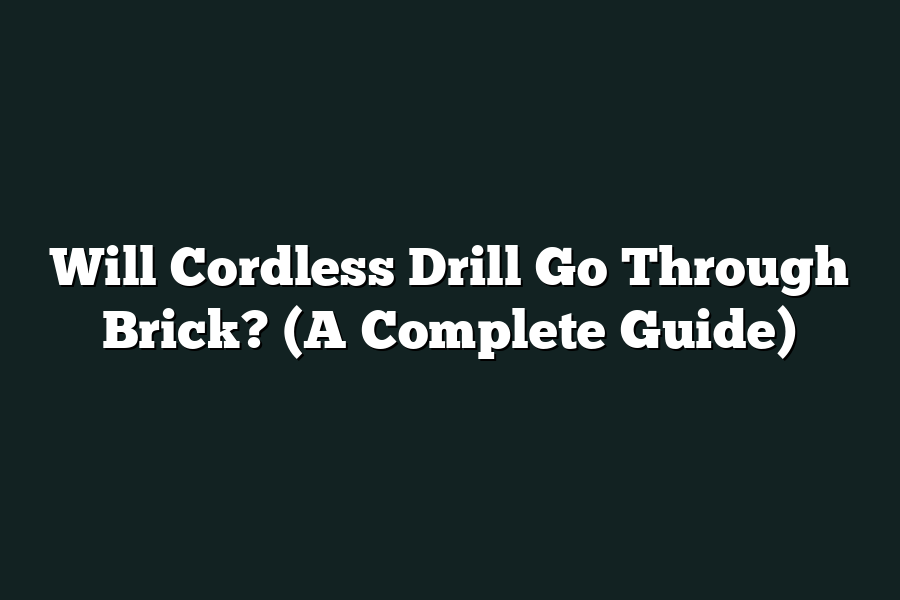Yes, a cordless drill can go through brick, but it depends on the type of brick and the power of the drill. For normal brick walls, you may need a powerful cordless drill with a masonry drill bit. It’s important to use the correct drill bit and technique to safely and effectively drill through brick without damaging the drill or the wall. Practice caution and start with a lower speed to ensure precision and control during the drilling process.
Ready to up your DIY game?
Imagine needing to drill into brick but unsure if your cordless drill is up to the task.
In this guide, we’ll explore all things cordless drills and brickwork.
From components to safety precautions, we’ve got you covered.
Get set to tackle that brick wall like a pro!
Table of Contents
Understanding the Components – Types of Cordless Drills and Drill Bits
When it comes to drilling through tough materials like brick, having the right tools for the job is essential.
Let’s dive into the key components you need to consider: types of cordless drills and drill bits.
Types of Cordless Drills
1. Drill Drivers:
The most common type of cordless drill, ideal for everyday drilling tasks.
They provide a good balance between power and versatility, making them suitable for a wide range of materials, including brick.
2. Hammer Drills:
Designed specifically for drilling into hard materials like masonry and concrete, hammer drills feature a hammering function that helps to break through tough surfaces such as brick more efficiently.
3. Impact Drivers:
While not designed for drilling, impact drivers excel at driving screws and fasteners into tough materials.
They can also be effective for light drilling tasks on brick surfaces.
Types of Drill Bits
1. Masonry Bits:
Specifically designed for drilling into hard materials like brick and concrete, masonry bits have a carbide tip for increased durability and precision when drilling through tough surfaces.
2. Carbide-Tipped Bits:
Featuring a carbide tip similar to masonry bits, these drill bits are versatile and can be used for drilling into a variety of materials, including brick, stone, and concrete.
3. Diamond Core Bits:
Ideal for more specialized drilling tasks, diamond core bits are highly effective for drilling precise holes in extremely hard materials like reinforced concrete and brick.
By understanding the different types of cordless drills and drill bits available, you can choose the right tools to tackle your brick drilling project effectively.
Whether you opt for a drill driver, hammer drill, impact driver, masonry bit, carbide-tipped bit, or diamond core bit, selecting the appropriate combination will enhance your drilling experience and ensure successful results.
Power Play – Unpacking the Importance of Drill Power
When it comes to drilling through tough materials like brick, one of the most critical factors to consider is the power of the drill you’re using.
In this section, we’ll delve into why drill power is essential for successfully drilling through brick and how different power levels can impact your drilling experience.
Why Drill Power Matters
The Impact of Drill Power on Brick Drilling
Drilling through brick requires a drill that can deliver sufficient power to penetrate the tough material effectively.
Here’s why drill power matters in this context:
Speed and Efficiency: A high-powered drill can make quick work of brick, allowing you to complete your drilling tasks faster and more efficiently.
Depth of Penetration: The power of your drill directly influences how deeply you can penetrate the brick surface. Greater power means you can drill deeper with ease.
Clean and Precise Holes: Insufficient power can lead to a frustrating drilling experience, resulting in messy, uneven holes in the brick. With the right amount of power, you can achieve clean and precise holes every time.
Case Study: Cordless Drill Power vs. Brick
To illustrate the importance of drill power when drilling through brick, let’s consider a case study comparing the performance of a low-powered cordless drill with a high-powered corded drill.
- The low-powered cordless drill struggled to make significant progress when drilling into brick, often stalling or overheating due to the lack of power.
- In contrast, the high-powered corded drill effortlessly powered through the brick, making smooth and efficient progress without any issues.
Expert Insights on Drill Power
According to a study by DIY experts at Popular Mechanics, drills with higher power ratings are significantly more effective at drilling through tough materials like brick.
The experts recommend opting for drills with at least of power for optimal performance.
Choose Wisely: Selecting the Right Drill Power for Brick Drilling
When selecting a drill for brick drilling tasks, consider the power rating of the drill as a crucial factor.
Look for drills with ample power to ensure smooth and successful drilling operations.
Remember, when it comes to drilling through brick, more power is often the key to achieving the best results.
In the next section, we’ll explore the impact of drill speed on brick drilling and how finding the right balance can elevate your drilling experience to the next level.
Stay tuned for more expert insights!
Techniques for Success: Best Practices for Drilling Through Brick
When it comes to drilling through brick, having the right techniques can make all the difference between a successful project and a headache-inducing disaster.
Let’s explore some best practices to ensure that your cordless drill can efficiently penetrate that tough brick surface.
1. Choose the Right Masonry Bit
The foundation of a successful drilling operation into brick starts with selecting the correct masonry bit.
Opt for a carbide-tipped masonry bit specifically designed for drilling through brick.
These bits are durable and can withstand the hardness of the brick material, providing a smoother drilling experience.
2. Use the Proper Drill Speed and Pressure
To effectively drill through brick, it’s crucial to maintain the correct drill speed and pressure.
Start by setting your cordless drill to a low speed to prevent overheating and ensure better control over the drilling process.
Apply consistent pressure without forcing the drill, allowing the bit to gradually work its way through the brick.
3. Begin with a Pilot Hole
Creating a pilot hole before drilling into the brick can help guide the masonry bit and prevent unnecessary damage.
Start by using a smaller masonry bit to establish a pilot hole, then switch to the larger bit for the main drilling operation.
This technique can enhance precision and accuracy when drilling through brick.
4. Use Water for Lubrication
When drilling through brick, the friction generated can lead to heat buildup, causing the bit to wear out quickly.
To counter this, consider using water as a lubricant while drilling.
Spraying water on the drilling site can help reduce heat, prolong the life of the masonry bit, and prevent the brick from cracking or chipping.
5. Maintain a Steady Hand and Position
Steadiness is key when drilling through brick to ensure a clean and precise hole.
Keep a firm grip on the cordless drill and maintain a steady hand throughout the drilling process.
Position the drill at a 90-degree angle to the brick surface to prevent skewing or deviating from the desired drilling path.
6. Clear Out Debris Regularly
Brick dust and debris can accumulate in the drilled hole, obstructing the drilling progress and affecting the hole’s quality.
Periodically stop drilling to clear out the debris using a vacuum or compressed air.
This practice helps maintain the efficiency of the drilling operation and ensures a clean breakthrough.
By following these best practices and techniques, you can increase the success rate of drilling through brick using a cordless drill.
Remember, patience and precision are key when working with tough masonry materials.
Happy drilling!
Safety First – Essential Safety Precautions When Using Cordless Drills on Brick
When it comes to using a cordless drill on brick surfaces, safety should always be the top priority.
In this section, I’ll guide you through the essential safety precautions to keep in mind to ensure a smooth and accident-free drilling experience.
1. Personal Protective Equipment (PPE)
Before you start drilling into brick with your cordless drill, make sure you have the necessary personal protective equipment (PPE) on hand.
This includes:
- Safety goggles to protect your eyes from flying debris
- A dust mask to prevent inhalation of brick dust
- Ear protection to reduce noise levels
2. Drill Selection
Choosing the right drill bit for brick is crucial to ensure a successful drilling process.
Opt for a masonry drill bit specifically designed for use with brick and other masonry materials.
These drill bits are equipped with a carbide tip that can handle the tough nature of brick without getting damaged.
3. Drill Speed and Pressure
When drilling into brick, it’s important to use the correct drill speed and apply the right amount of pressure.
Excessive speed or pressure can lead to overheating of the drill bit or even cause it to break.
Slow and steady wins the race when it comes to drilling into brick – maintain a moderate speed and let the drill do the work.
4. Positioning and Marking
Before you start drilling, carefully mark the spot on the brick where you want to drill.
Use a pencil or marker to make a clear indication of the drilling point.
Double-check the position to ensure accuracy and avoid any unnecessary mistakes or damage to the brick surface.
5. Depth Control
Ensure that you have control over the drilling depth to prevent going too deep into the brick.
Many cordless drills come with depth control settings that allow you to set a specific drilling depth.
Adjust this setting according to your requirements to avoid drilling deeper than needed.
6. Battery Life Monitoring
Keep an eye on the battery life of your cordless drill throughout the drilling process.
Running out of battery power midway through drilling can lead to incomplete holes or even get the drill bit stuck in the brick.
Charge your drill before starting the task, or have a spare battery on hand for uninterrupted drilling.
By following these essential safety precautions when using a cordless drill on brick, you can ensure a smooth and accident-free drilling experience while protecting yourself and your equipment.
Remember, safety always comes first when working with power tools.
Final Thoughts
We’ve unraveled the mystery of whether a cordless drill can go through brick by delving into its capabilities and limitations.
By understanding the types of cordless drills and drill bits, along with the crucial role of drill power, you’re now equipped with the knowledge to tackle drilling through brick successfully.
Remember, mastering the right techniques and prioritizing safety precautions are key to a job well done.
So, whether you’re a seasoned DIY enthusiast or a first-time driller, take these insights and put them into action.
Grab your cordless drill, choose the right bit, apply the correct technique, and ensure your safety gear is in place.
With these steps in mind, you’re ready to take on any brick surface with confidence.
Happy drilling!

